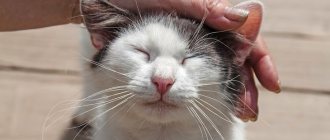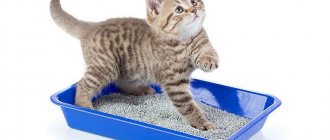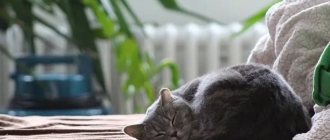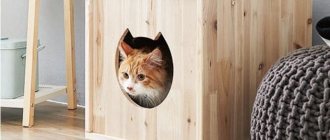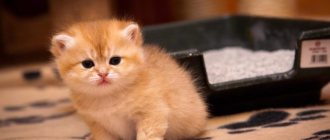Your pet’s habit of using a scratching post will protect your home from destruction: you won’t have to return from work to find
ragged walls or a damaged sofa . Accustoming a cat to a scratching post is just as important as to accustoming a cat to a litter tray - therefore, it is necessary to carefully consider the issue of education even when the animal is at a young age. If you already have an adult pet, it doesn’t matter, he can also be taught good manners, even if it takes a little more time.
Why do cats need to sharpen their claws?
Sharpening their claws is a natural need for cats, and they do not do it to infuriate their owner. This is how animals get rid of the keratinized parts of their claws - this is a kind of hygienic procedure, cleaning. Another purpose of this action is to mark territory. Special glands located on the paw pads secrete a secretion that is accessible only to the animal's sense of smell.
For purely domestic animals, this is just exercise and gymnastics. The cat stretches and kneads its muscles. It is easier to accustom a cat to a scratching post if it has not yet developed the bad habit of scratching wallpaper and furniture. It is best to do this in childhood - starting from the age of two months, you can conduct playful activities with the kitten.
Selection and installation of a scratching post
Smart owners understand that cats obey instincts, and it is a waste of time to scold them for damaging furniture. Observing the preferences and physiological characteristics of the cat will help you choose the right scratching post:
- Watch your pet, take a closer look at how he prefers to sharpen his claws - on a horizontal surface or on a vertical one. Based on your observations, choose a suitable model in the store (mat, column, curved form).
- The size of the fight must correspond to the size of the animal. The scratching post should be such that the cat can stretch out freely while scratching it.
- If the fight is placed unstable, the cat may ignore it. Choose a model with a wide and heavy base.
If you have the time and desire, you can make a scratching post yourself. It will be cheaper, and you can make just such a thing that fits perfectly into your interior.
Types of structures
What types of scratching posts will be functional, fit into the interior, help the cat relieve stress, and help the owners keep their furniture upholstery, shoes and wallpaper intact?
- Vertical
. All versions of floor posts braided with rope are popular due to their small size and structural stability. Vertical columns start from 50 cm (suitable for accustoming a kitten to a scratching post) and are limited only by the budget and the height of the ceilings in the owners’ house. A single vertical column can be easily placed in small spaces to target areas that cats like to pick at.
- Game complexes
from several vertical planes of different levels, with shelves and beds, perhaps with different textures of materials, they take up more space and are more expensive.
- Planks
. The advantages of planks braided with jute, rope, fabric, laces or upholstered in fabric include mobility and small size. They can be used to cover the cat’s favorite place on the wallpaper or furniture.
Whatever scratching post you choose, the main thing is that it copes with the expected tasks and does not just accumulate dust.
Size and material
Observe your cat before purchasing: does she like fabric surfaces or does she manicure on cabinet furniture? Perhaps she liked wood or a completely unusual material? Observation will help you decide on the choice of covering and will eliminate the fact that the animal will ignore the scratching post.
Owners often learn how to accustom an adult cat to a scratching post through trial and error. To avoid them as much as possible, you need to pay great attention to the habits and character of your pet.
You should stock up on patience and treats to reinforce the results.
Offer different materials: strips of corrugated cardboard, balls of woolen thread.
The height and thickness of the scratching post should correspond to the size of the animal. The Maine Coon will not sharpen its claws on a small and unstable board - it simply will not impress him. The opposite situation: it will be difficult for a kitten to peel off a surface with a large weave - it will get caught in its claws and will not be able to get out.
Where to put
If attempts to tear up furniture or a wall have already been made, then it is best to place the scratching post in this particular place. After installing the device, it is better to block off the places of other “attacks” so that they do not attract the pet’s attention again.
It’s good if the cat independently appreciates all the charm of the new item. If the animal does not understand the first time why fighting is needed, continue training until the necessary skill is formed.
After your pet has become familiar with the scratching post and has learned to use it, and you are sure that the bad habit is already a thing of the past, start moving the scratching post. Move it daily, little by little, until it is in the place you have chosen for it.
If the apartment is large or there are several cats in the house, it is useful to purchase not one, but several scratching posts and place them in different places. The best place to place a scratching post is next to the bed. As soon as the cat wakes up and wants to stretch, she will turn to the device.
Homemade claw clippers
The owner can make this important and valuable item for the home himself.
So it will be unique and will decorate the interior. The easiest option is to wrap rope around the legs of chairs and the kitchen table. For these purposes, it is better to take jute rope. Its cost is low. Use glue to attach it to the legs. It should fit snugly and completely cover part of the chair. The use of glue can be replaced with a stapler. The work must be carried out carefully. The braces must not injure the animal’s paws. After completing the work, the rope can be painted in different colors. It is allowed to use one shade that matches the interior of the kitchen.
A scratching stick is made in a similar way from a large ceramic or metal vase. It can also be wrapped with coarse tape or rope. The main thing is that the vase is stable. To do this, it can be glued to a prepared heavy base or filled with stones.
A scratching pad made from unwanted carpet or rug will be an excellent option for scratching. The layer is cut to the size of the side of the wardrobe. A rectangle of carpet is firmly fixed in the chosen place. All is ready. Your pet should like this device. In addition to the fact that you can tear it, it is easy to climb up to the ceiling.
A scratching post is a useful device. It doesn’t matter what it looks like, the main thing is that the cat is happy and uses it for its intended purpose.
How to accustom a kitten to a scratching post
It is best to start training as soon as the kitten appears in your home - in parallel with learning to use the litter box.
The kitten must be introduced to the device. To arouse his interest, you can use toys and pendants: for example, move a fishing rod along a scratching post to attract the baby’s attention. You can use special scents that attract cats - such sprays can be purchased at a pet store.
Explain to your baby the purpose of the scratching post. Place his paws on the scraper and move carefully over the surface of the object. It is important to interest him. When he understands what the dog is for and starts using it on his own, be sure to praise the kitten and pamper him with a treat.
Be sure to stop attempts to sharpen your claws on furniture or wallpaper. Use all possible methods of influence for this - strict intonation, scaring techniques (claps, knocks), you can use water (spray) as a last resort. It is very important to develop the necessary habit from childhood.
Never yell at or intimidate your pet. Speak in a stern voice - this will be enough. Cats respond well to intonation. Never physically punish your pet - he may become fearful and begin to treat you with caution or hostility. Act strictly but kindly.
It’s a rare pet who understands what they want from him the first time, especially if he’s still a baby. Be patient and continue practicing until a useful habit is fully formed. As a rule, with regular training, a kitten masters a new skill in about a week.
How to train an adult cat to use a scratching post
The situation is much more complicated with an adult cat that has already formed a bad habit. It is always easier to educate than to re-educate. Be patient and don't get irritated or lose your composure if the animal is difficult to re-educate. Introduce your pet to the device, try to arouse its interest, use attractive sprays and toys. And never forget to praise and reward when successful.
Every time a cat tries to sharpen its claws in a forbidden place, immediately take it to the scratching post, place its paws on the surface and move them. Do not hurt the cat and do not swear - speak in a calm voice, stroke him. If he returns to the forbidden place, allow yourself a stern intonation, and then take him back to the fight. Be persistent.
Ideally, if the cat has no access to previous crime scenes during retraining, it will be easier for him to accept the new thing in the absence of the old one.
Be especially gentle with older animals - adapt to their wishes as much as possible. If a cat has been scratching the sofa all its life, it is easier to turn it into a large scratching post with your own hands - cover it with special material and strengthen it. Otherwise, the elderly kitty will become very stressed and may get sick.
Why does a cat not like a scratching post and what to do?
How to accustom a cat to a scratching post if he doesn’t like it? Be calm and progressive: with cats, just like with people, developing new habits takes time.
You can help your family pets with praise, play, and smells. Create pleasant associations with the scratching post and unpleasant ones with the wrong place.
The smells of lavender, ginger, rosemary, and lemongrass will help in the fight against cat scratches - they are absolutely not liked by mustachioed cats. They can be used to treat scratched surfaces so that a purchased scratching post remains the only convenient option.
Always, regardless of whether you are busy or not, praise your pet in a gentle voice in a sing-song voice, stroke behind the ear, give a treat as soon as she has sharpened her claws correctly.
For “hardcore evaders” from scratching posts, use the heavy artillery: catnip and valerian solution. Treat the surface of the scratching post with them or try to place a tasty morsel at the top - let the kitty try to get to it by clinging with her claws and climbing up.
Training a cat to use a scratching post is not a war that must be won at any cost, but a valuable skill that will be developed sooner or later. Play together with a feather or your favorite toy next to the accessory, place the cat's paw on the scratching post, and show how the device works using the example of another cat.
The older and taller the cat becomes, the faster it “grows out” of the old scratching post. Update the accessory in a timely manner - then there will be no sudden failures and vandalism of the furniture.
Training in action
How to toilet train a kitten: options for making it go to the litter box
The kitten needs to be accustomed to the scratching post gradually, because the baby may not immediately understand what it is. What is the fastest and easiest way to train a pet to use a scratching post? It is impossible to answer this question unequivocally. Everyone introduces their pets to the scratching post in different ways. This is understandable, because each cat has its own habits, character and behavioral characteristics.
Important! There are a lot of options on how to accustom a kitten to a scratching post. But before that you should prepare. First you need to decide on the place where the claw sharpener will be placed.
Places that have been used more than once by the animal as a scratching post will need to be hidden from the reach of its claws.
Impregnations for better training
Smells and treats motivate furry hunters, like good prey. Here are a few ways to train an adult cat to use a scratching post.
Rub the dry collection of catnip in your hands, put it in a linen bag or toy and secure it to a scratching post. The delicate lemon scent of this herb changes the animal's behavior.
The catnip tincture should be sprayed very carefully and do not forget to dilute with water. The dry collection can be poured with boiling water (300 ml per tablespoon) and cooled in a dark place. You also need to apply it carefully: it leaves stains on fabrics. By the way, the smell of catnip is the best antidepressant for humans.
The active substance actinidin (an antidepressant from catnip) is also found in the familiar valerian. Try this herb or its analogues. There is a version that the smell of the plant is similar to the smell of adults ready to mate. This may be why kittens up to five months old and castrated cats are practically indifferent to valerian.
Look for ready-made solutions at the pet store, but beware of low-quality products. It can cause allergies in pets. Vet pharmacies have several types of products that help scare away or attract animals.
Nature's and Beaphar "Stop it Cat" sprays repel adult cats and eliminate urine and claw mark odors.
Ready-made dry herbal mixtures of domestic production containing valerian perfectly attract animals.
Owners know their pet better and intuitively understand how much to spray the scratching post. Usually one or two sprays are enough for the kitty to smell the smell and run to get to know the scratching post better.
Common types
In addition, teaching a cat to scratch a scratching post will be easier if you choose the right type of scratching post. When making this choice, you should take into account the habits and temperament of your pet.
So, what types of scratching posts are there? There are 7 types of them :
- Column. It will benefit not only the pet’s claws, but also its skeleton and muscles, since the mustachioed one will be able to climb on it and frolic very happily.
- House. In addition to the fact that the cat will be able to sharpen its claws, it will also acquire a secluded place for itself. An excellent option would be to choose a house with parameters of 30x30 cm. You can train a cat to a house with a scratching post in the same ways as to a regular one.
- Playground. It is a combination of a labyrinth and a variety of stairs, which will be excellent entertainment for the animal.
- Cardboard scratching post. Its disadvantage is its fragility, since it wears out quickly. A plus is that this scratching post is made of environmentally friendly material.
- Jugite is an excellent material for sharpening claws.
- Sisal is more stable in use than the above options.
- Wooden is the most durable of all types.
© shutterstock
